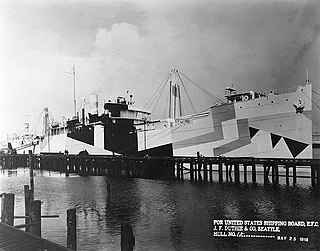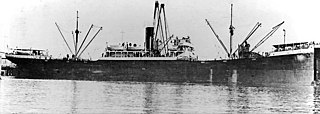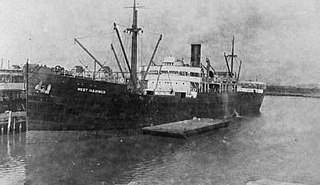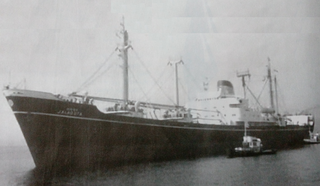The SS City of Flint was a cargo ship of a type known colloquially as a Hog Islander, due to it being built at the Hog Island Shipyard, Philadelphia by American International Shipbuilding for the United States Shipping Board (USSB), Emergency Fleet Corporation. City of Flint was named to honor the citizens of Flint, Michigan for their effort in Liberty Loan drives during World War I.

USS Charger (CVE-30) was an escort carrier of the United States Navy during World War II converted from a commercial C3-P&C cargo/passenger liner hull built as Rio de la Plata intended for the Moore-McCormack company's American Republics Line serving the east coast of South America. The ship was requisitioned for conversion to an escort carrier type intended for Royal Navy use and initially commissioned as HMS Charger (D27). Days later the transfer was rescinded with the ship returning to U.S. Navy control to become USS Charger which operated throughout the war as a training ship on the Chesapeake Bay with two ferry missions to Bermuda and Guantánamo Bay, Cuba.

USS Alameda, was a United States Navy tanker in commission from 1919 to 1922. She was built as the civilian tanker SS Alameda, but transferred to the U.S. Navy after completion in 1919. She was sold for commercial service and operated under the names SS Olean and SS Sweep before she was transferred to the Navy again in World War II as USS Silver Cloud (IX-143).

USS Algorab (AKA-8) was laid down as Mormacwren, one of the earliest Maritime Commission-type C2 ships, on 10 August 1938 by the Sun Shipbuilding & Drydock Co., Chester, Pennsylvania as hull 177 for Moore-McCormack. Mormacwren was acquired by the United States Navy 6 June 1941, commissioned 15 June 1941 as USS Algorab (AK-25) and was redesignated an attack transport on 1 February 1943 with the hull number chanted to AKA-8. Algorab decommissioned on 3 December 1945 and was delivered to the Maritime Commission on 30 June 1946 for disposal, purchased by Wallem & Co. on 4 April 1947 for commercial service.

SS Munargo was a commercial cargo and passenger ship built for the Munson Steamship Line by New York Shipbuilding Corp., Camden, New Jersey launched 17 September 1921. Munargo operated for the line in the New York-Bahamas-Cuba-Miami service passenger cargo trade. In June 1930 the United States and Mexican soccer teams took passage aboard Munargo from New York to Uruguay for the 1930 FIFA World Cup. The ship was acquired by the War Shipping Administration and immediately purchased by the War Department for service as a troop carrier during World War II. Shortly after acquisition the War Department transferred the ship to the U.S. Navy which commissioned the ship USS Munargo (AP-20). She operated in the Atlantic Ocean for the Navy until returned to the War Department in 1943 for conversion into the Hospital ship USAHS Thistle.

SS Fort Lee was a T2 tanker built for the United States Maritime Commission during World War II. The ship was assigned by the War Shipping Administration for operation by the Bernuth Lembcke Co. and operated in the Atlantic and Mediterranean early in its career.
SS Manistee was an Elders & Fyffes Ltd banana boat that was launched in 1920. She was one of a numerous class of similar banana boats built for Elders & Fyffes in the 1920s.

USS West Bridge (ID-2888) was a Design 1013 cargo ship in the United States Navy during World War I. She was begun as War Topaz for the British Government but was completed as West Bridge. After being decommissioned from the Navy, the ship returned to civilian service as West Bridge, but was renamed Barbara Cates, and Pan Gulf over the course of her commercial career under American registry.

Seisho Maru was a cargo ship for Mitsui Bussan Kaisho in military service that was sunk by an American submarine during World War II. The ship had been built as SS West Caruth, a cargo ship for the United States Shipping Board (USSB) shortly after the end of World War I. Shortly after completion, the ship was inspected by the United States Navy for possible use as USS West Caruth (ID-2850) but was neither taken into the Navy nor ever commissioned under that name. Before being sold to Japanese owners in 1928, she was also known as SS Exmoor and SS Antonio Tripcovich.
HMS Hilary was a Booth Line passenger steamship that was built in Scotland in 1908 and operated scheduled services between Liverpool and Brazil until 1914. In the First World War she was an armed merchant cruiser (AMC) until a U-boat sank her in the Atlantic Ocean in 1917.
SS Louise Lykes was a Type C2-F ship built in 1941 at Federal Shipbuilding of Kearny, New Jersey. She sailed for the Lykes Brothers Steamship Company out of New Orleans, Louisiana. On 9 January 1943, she was sunk with all hands in the North Atlantic by U-384.
SS Santa Elisa was a refrigerated cargo ship built for the United States Maritime Commission by Federal Shipbuilding of Kearny, New Jersey in 1941.
SS or MS Stag Hound or Staghound may refer to:
SS Fairport was a Type C2-S-E1 cargo ship built by Gulf Shipbuilding for the Waterman Steamship Company. She was sunk by U-161 on 16 July 1942. All hands were rescued by an American destroyer.
SS Express was a Type C3-E cargo ship of American Export Lines that was sunk by I-10 in June 1942 in the Indian Ocean. The ship, built in 1940 by Bethlehem Shipbuilding in Quincy, Massachusetts, was one of eight sister ships built for the United States Maritime Commission on behalf of American Export Lines. Out of a total of 55 men aboard the ship at the time of its torpedoing, 13 were killed; most of the other 42 landed on the coast of Mozambique six days after the sinking.

SS West Maximus was a steel-hulled cargo ship built for the United States Shipping Board's emergency wartime construction program during World War I. Completed too late to see service in the war, West Maximus spent the interwar years in commercial service.

The T3 tanker, or T3, are a class of seaworthy large tanker ships produced in the United States and used to transport fuel oil, gasoline or diesel before and during World War II, the Korean War and the Vietnam War. The T3 tanker classification is still used today. The T3 tanker has a full load displacement of about 24,830 tons.

SS Jalabala was the cargo steamship owned by Scindia Steam Navigation Company Ltd., the British Indian shipping company, which was completed in 1927. She was torpedoed and sunk in the Laccadive Sea west of Cape Comorin by the German submarine U-532 with the loss of five of her 77 crew members on 11 October 1943 during World War II.
SS Robert F. Hoke was a Liberty ship built in the United States during World War II. She was named after Robert Hoke, Confederate Army Major General, politician, and Director of the North Carolina Railroad.

Splinter fleet or Splinter navy was a nickname given to the United States wooden boats used in World War II. The boats served in many different roles during the war. These boats were built in small boatyards on the West coast and East coast, Great Lakes and the Gulf of Mexico. They could be built quickly, in just 60 to 120 days. Most of the boats were built by boatyards that already had the tools and knowledge from building yachts, sailboats and motor boats. Many were built by craftsmen in family-owned small businesses. Under the Emergency Shipbuilding Program and War Shipping Administration contracts went out to over fifty boatyards across the country. The boats were built for the US Navy, the United States Army Air Forces, United States Coast Guard, and US Army. Some of the wooden boats went to Allied nations on the Lend-Lease program.










